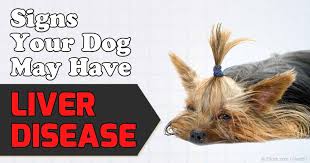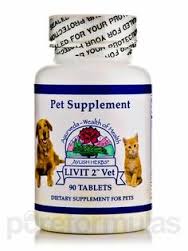 Canine liver disease is the fifth leading cause of death for dogs, and it’s estimated that three percent of all diseases veterinarians see are connected to the liver. Canine liver disease has many causes, such as physiological, physical and chemical.
Canine liver disease is the fifth leading cause of death for dogs, and it’s estimated that three percent of all diseases veterinarians see are connected to the liver. Canine liver disease has many causes, such as physiological, physical and chemical.
The liver is the largest gland in the body and one of the most important organs. It carries out essential chemical processing , including the handling of nutrients from digestion and the elimination of toxic substances. When it’s complex mechanisms go wrong, the body can suffer in many ways.
First and foremost, you need a medical diagnosis to determine the exact nature of the problem. Liver disease most commonly effects older dogs, however, signs of a liver ailment can be confused or associated with, many other medical problems.
In the early stages of liver disease the liver swells and enlarges. As the disease progresses, the liver cells die and are replaced by scar tissue. The liver then becomes rubbery and firm. This condition is called cirrhosis and it is not reversible.
Eighty percent of liver cells must die before the liver begins to fail. The signs of liver failure are jaundice, hepatic encephalopathy, ascites, spontaneous bleeding and dependent edema.
Jaundice-With impaired liver function, bile accumulates in the blood and tissues, staining the tissues yellow. This can be seen in the yellow appearance of the white of the eyes and in the mucous membranes of the gums and tongue. Bile excreted in the urine turns the urine dark brown (the color of tea)
Hepatic Encephalopathy-This is a type of brain inflammation caused by high levels of ammonia and other toxins in the blood. Ammonia is the by product of protein metabolism, and is normally removed from the bloodstream by a healthy liver. When the liver is sick, ammonia accumulates to toxic levels and exerts a poisonous effect on the brain.
Dogs with hepatic encephalopathy develop incoordination, sporadic weakness, disorientation, head pressing, behavioral changes, drooling, stupor and mental dullness.Symptoms become more severe after a high protein meal. Siezures and coma occur when hepatic encephalopathy is advanced.
Ascites-Ascites is the accumulation of fluid in the abdomen. In liver disease, it is caused by low serum proteins and increased pressure in the veins that supply the liver. A dog with ascites has a swollen or bloated look. Thumping on the abdomen creates a dull, flat sound.
Bleeding-Spontaneous bleeding occurs with advanced liver disease. Common sites of bleeding are the stomach, intestine and urinary tract. Blood may be notes in the vomitus, stool or urine. Pin sized hemorrhages may be seen on the gums. Bruises can appear under the lips and skin.
Dependent Edema-Swelling of the abdominal wall and lower legs is related to malnutrition and low serum protein levels. It is not as common in liver disease as it is in congestive heart failure.
Some breeds of dog may be more predisposed to liver disease than others. These include Bedlington Terriers, West Highland White Terriers, Skye Terriers, Keeshonds, Labrador Retrievers and Dalmatians. Breeds predisposed to chronic hepatitis include the Doberman Pinscher (mainly seen in females), Cocker Spaniel, Labrador Retriever, Standard Poodle and Scottish Terrier.
Exposure to hepatotoxins is more frequent in free roaming dogs with access to chemicals, heavy metals, stagnant standing water, pesticides, poisonous plants or drugs. A hepatotoxin is a toxic chemical substance that damages the liver. It can be a side-effect of medication, or found naturally, as microcystins, or in laboratory environments. Free roaming dogs are also more likely to suffer acute blunt trauma to their liver. Healthy dogs exposed to dogs that have leptospirosis, canine infectious hepatitis or canine adenovirus infection have a greater risk of developing those diseases, which contribute to liver damage.
Only a skilled veterinary professional can assess a dog and perform the tests needed to confirm a diagnosis of liver disease
 Regular check ups, which include blood work, can help catch liver trouble early on. If you see some of these symptoms, consult your veterinarian.
Regular check ups, which include blood work, can help catch liver trouble early on. If you see some of these symptoms, consult your veterinarian.
- Loss of appetite
- Weight loss
- Vomiting or diarrhea
- Increased thirst
- An unstable walk
- Increased need to pee
- Confusion
- Yellowish eyes, tongue, or gums (jaundice)
- Signs of weakness
- Blood in his pee or poop
- Seizures
- Irritability
- Swollen Abdomen
Antioxidant Therapy:

Milk Thistle– For any liver condition such as hepatitis, chronic liver disease or inflammation of the bile ducts, some veterinarians recommend milk thistle, which you can find in health food stores. This herb has amazing healing effects and can actually regenerate the liver.
You can add milk thistle to any treatment program, and it may be the only thing that will truly help. You will notice a big improvement with this herb. Your veterinarian can gauge improvement by doing standard liver enzyme tests. This is a very organ specific herb, so once the enzyme level normalizes you can stop giving the herb.
Studies have validated milk thistles protective effect against poison. It works protectively and also repairs the liver from exposure to poisons. If the animal is on any medication that puts a burden on the liver, use milk thistle daily. Heart worm medication and some cancer medication is hard on the liver. If the animal has a damaged liver or a history of liver problems, give milk thistle daily for one month.
Dosage: One quarter to one half the human dose for a forty pound dog. Start at the lower dose to avoid any stomach upset, then work up to a higher level.
A. Greig Howie, DVM
 Ayurvedic Herbs for the Liver
Ayurvedic Herbs for the Liver
There is a Ayurvedic herbal combination called Livit 2. The product is available in liquid form for small dogs and tablet form for larger animals. The formula contains multiple herbs, among them kutli, which has been shown by research to detoxify the liver, eliminate excess or impure bile and purify the blood. And amla, which helps rejuvinate the immune system and increase the red blood cell count. Amla is the richest source of vitamin C among all fruits and also contains phytochemicals recognized for antioxidant properties and immune system enhancement.
This formula is recommended when blood tests reveal elevated liver enzymes, a sign of trouble in the liver that could indicate such problems as acute hepatitis, congestion or a build up of toxicity from medication. Livit 2 protects, nourishes and detoxifies the liver. Within two to three weeks the animal usually feels better, although it will often take longer for the tests to show a normalization of liver enzymes. Blood tests done a month after starting the product usually show a decrease toward normalization of the enzyme levels. After another two months there is typically a dramatic drop.
This product is very protective against the toxicity of of drugs when animals undergo chemotherapy. We see improved appetite, more energy, less vomiting, and in general fewer problems related to the medication. Livit 2 supports any therapy and medication by fortifying and protecting the liver.
 Dosage: Small dogs-10 drops of Livit 2 liquid twice daily per 10 pounds of body weight, dogs up to 30 pounds , 1 tablet twice daily, dogs up to 60 pounds, 1 tablet 3 times daily, larger dogs 2 tablets twice daily. Use the formula for at least 3 months or until liver enzymes normalize, or long term while the animal is taking strong medication such as phenobarbitol for epilepsy or chemotherapeutic drugs.
Dosage: Small dogs-10 drops of Livit 2 liquid twice daily per 10 pounds of body weight, dogs up to 30 pounds , 1 tablet twice daily, dogs up to 60 pounds, 1 tablet 3 times daily, larger dogs 2 tablets twice daily. Use the formula for at least 3 months or until liver enzymes normalize, or long term while the animal is taking strong medication such as phenobarbitol for epilepsy or chemotherapeutic drugs.
Tejinder Sodhi, DVM
Homeopathic Remedy:Several natural remedies can powerfully enhance the healing process and treatment program for liver failure. Conventional medicine doesn’t have very good answers for this condition. Most of these cases are chronic and will take months to heal.
The first remedy is Theratox, a homeopathic combination to detoxify the liver. Sick livers are always loaded with toxins. Cleansing is an important first step to restoring liver health.
The second remedy is called Liv-C, a Chinese herbal combination . The formulation builds up the liver on a nutritional level. The two major ingredients are bupleurum root and peony root.
The third part of the program is Liver Liquescence, intended for building up the liver on a “energy” level. The length of time these remedies are used will vary. Have your animals liver function tested at two weeks and then after one month. You can taper off the remedies as the liver becomes healthier.
You may also try raw beets and add to food, which help detoxify the liver. Feed one teaspoon daily for a 60 pound dog.
 Dosage:
Dosage:
- Theratox-10-15 drops daily, depending on the severity of the condition. Pull away the animals lips and apply the drops to the mucous membranes inside. In a crisis, give the drops hourly for four hours and then three to four times a day until symptoms are relieved.
- Liv-C- Give daily with meals for one to three months. Dogs up to 15 pounds, 1 capsule, dogs up to 40 pounds, 1 capsule twice, dogs up to 80 pounds, 2 capsules twice, giant breeds, 2-3 capsules twice daily.
- Liver Liquescence-Give twice daily, before meals. Smaller dogs, 1/4 teaspoon each time, larger dogs, 1/2 teaspoon.
Ron Carsten, DVM






